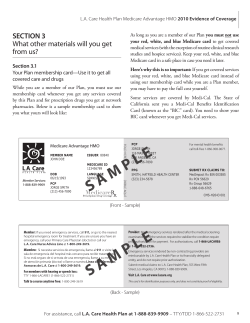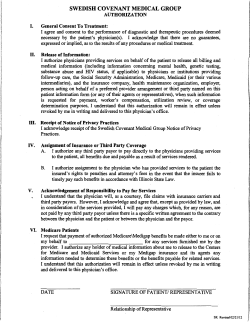
The 2015 Proposed Medicare Physician Payment Fee Schedule :
The 2015 Proposed Medicare Physician Payment Fee Schedule : What It Means for Your Practice In the July 2014 Proposed Rule for the 2015 Medicare Physician Fee Schedule, CMS advances several initiatives that, in combination with already existing programs, can affect the reimbursement physicians will receive from Medicare for the services they provide. There are initiatives related to the ongoing Physician Quality Reporting System (PQRS) and its reporting options/mechanisms as well as to the requirement to show meaningful use of electronic health records (EHR); the Value Based Modifier (VM), which will be activated for groups of 100 or more eligible providers in 2015, for groups of 10-99 in 2016, and for small and solo practices in 2017; and the issuance of Quality Resource Use Reports (QRUR). All of these are interrelated and could impose penalties as high as 9% for large practices (100 or more) in 2017. If a group were to be penalized the maximum 2% for failing to fulfill PQRS requirements, and the 3% for failing to show meaningful use of EHR, it is likely it would then be penalized the maximum 4% based on the VM, which, added to the current 2% drop in Medicare fees put in place by the federal sequester, would make for a total 11% lower reimbursement for all Part B Medicare services rendered in 2017. This flow chart illustrates how the various components can combine to affect the physician payment. Important facts and dates to consider are discussed below. The Physician Quality Reporting System (PQRS) The PQRS comprises a group of quality measures that physicians must report on when they file claims for the Medicare patients to whom the specific measures apply. Currently the measures can be listed on the claims form, but in future years reporting will be done through electronic health records and registries. A chart with the 2014 measures that are relevant to psychiatry is posted on the APA’s website. A new chart will be posted with the 2015 measures and domains when the rule is finalized. A PQRS payment adjustment of -1.5% will apply to all of a physician’s Medicare Part B services in 2015 if the minimal quality measure reporting requirements were not met in 2013 (for that year only one measure had to be reported for one patient). In 2016 the adjustment will be -2% for physicians who failed to meet the 2014 requirements (at least 3 measures must be reported on for 50% of the applicable patients before the end of the year). For 2017 and beyond, the penalty will remain at 2%, but the requirements that need to be met to avoid that penalty will increase in 2015. To avoid the 2% penalty in 2017, the Medicare Physician Fee Schedule Proposed Rule for 2015 requires reporting at least 9 measures across 3 domains for a minimum of 50% of Medicare patients for whom the 1 © American Psychiatric Association Office of Healthcare Systems & Financing, October 2014 measures apply in 2015. Information on the 2015 PQRS will be posted on the APA website as soon as the rule is finalized. In summary, to avoid being penalized for not participating in the PQRS: 2015 (-1.5%) – you must have reported at least 1 measure for 1 patient in 2013. 2016 (-2%) – you must have reported on at least 3 measures for 50% of your Medicare patients for whom the measures were applicable in 2014. 2017 (-2%) – you must report on at least 9 measures across 3 domains for 50% of your Medicare patient for whom the measures are applicable in 2015. PQRS reporting is one of the variables that will be used to calculate the Value Modifier (VM) discussed below. If you fail to comply with the requirements of the PQRS, this will be one factor in determining a possible further diminution of your Medicare reimbursement. (It’s a definite that you will have a -2% PQRS penalty, and in all likelihood a -2% VM penalty if you don’t successfully participate in PQRS.) There are very specific and various ways to report to PQRS (see links in schematic). Information about the current PQRS requirements in place can be found on the APA’s website. A new version of this information will be posted as soon as the 2015 Proposed Rule is finalized. The Value Modifier (VM) In 2010, as part of the Affordable Care Act (ACA), Medicare was required to establish a value-based payment modifier, or Value Modifier, to enable differential payment under the Medicare Physician Fee Schedule (PFS) based upon the quality of care provided compared to the cost of that care during a set performance period. The statute requires the Value Modifier to be budget neutral, which means that any increase in payments to high performing individual physicians and groups of physicians must be equal to the reduction in payments to low performing individual physicians and groups of physicians. The Value Modifier, which will be applied to raise or lower fees is determined by a formula based on quality data (determined in part by the PQRS data) and cost data, which is based on a beneficiary’s use of the Medicare program. How the cost of the beneficiary’s care is attributed to a provider or group of providers is based on a defined formula. The value rating, which determines whether you will receive a bonus or a penalty, is based on comparing your practice with others within the same size classification. Quality Tiering © American Psychiatric Association Office of Healthcare Systems & Financing, October 2014 2 Quality tiering is what the analysis is called that is used to determine the VM, which will determine the nature of the reimbursement adjustment (upward, downward, or neutral) and the percentage of that adjustment. The tiering is based on both quality of performance (derived from the PQRS) and cost measures, derived from the cost of a beneficiary’s care as attributed to a group or individual physician. Quality tiering will determine if a practice’s performance is statistically better, equal to, or worse than the national mean (see table below). 2017 Proposed VM Adjustments Based on Quality Tiering Cost/Quality Low quality Average quality High quality Low cost 0 +2 +4 Average cost -2 0 +2 High cost -4 -2 0 For 2015, groups of 100 or more eligible providers can opt to participate in quality tiering. This could result in an upward, downward, or neutral VM. Adjustments will be made based on 2013 data. Those who do not participate will not be affected by the VM in 2015, but may still be subject to a PQRS penalty (see discussion above). Quality tiering will be mandatory for groups of 10 or more eligible providers in 2016. However, groups of 10-99 will be held harmless from the downward adjustment for that first year. The data that is used to determine the VM in 2016 is based on 2014 Medicare claims. CMS has proposed to make quality tiering mandatory for all eligible Medicare providers in 2017. Groups of 2-9 and solo practitioners will be held harmless from the downward adjustment in 2017. The adjustment will be determined based on 2015 Medicare claims. In summary: The VM is based on two-year-old data obtained from the PQRS and Medicare claims, as calculated through quality tiering, and reported through Quality Resource Use Report (QRUR). The Quality Resource Use Report (QRUR) The QRUR is a feedback document that providers can use to determine how they compare to their peers. CMS believes that the QRUR will give providers the opportunity to “take action” and make necessary corrections based on the information they receive. The QRURs will preview information about a groups’ quality and cost performance rates for the VM. 3 © American Psychiatric Association Office of Healthcare Systems & Financing, October 2014 CMS has recently mailed out QRURs based on care provided in 2013 to all groups and solo practitioners. These 2013 QRURs display a practice’s quality and cost composite scores, which are used to calculate the VM. For a group practice of 100 or more eligible professionals that elected quality tiering, the 2013 QRUR displays the group’s 2015 Value Modifier payment adjustment. The QRUR establishes quality and cost performance based on the Quality Composite Score. Quality Composite Score The Quality Composite score summarizes a medical group practice’s performance on quality indicators across up to six equally weighted quality domains (Clinical Processes/Effectiveness, Patient and Family Engagement, Population/Public Health, Patient Safety, Care Coordination, and Efficient Use of Healthcare Resources). Standardized scores reflect how much a group’s performance differs from the national mean performance on a measure-by-measure basis. A quality composite score of +1 or higher places the provider in the “high quality” tier. A score of -1.0 or lower places the provider in the low quality tier. The same methodology will be used in 2016 for groups of 10-99, and in 2017 for all groups and solo providers. The Cost Composite Score The Cost Composite Score summarizes a medical practice’s performance on costs across two equally weighted cost domains: 1.) Per capita costs for all attributed beneficiaries; and 2.) Per capita costs for beneficiaries with specific conditions (diabetes, coronary artery disease, chronic obstructive pulmonary disease, and heart failure). Standardized scores reflect how much a group’s performance differs from the national mean performance on a measure-by-measure basis. All comparative cost data are risk adjusted to account for differences in patient characteristics that may affect costs, including age, gender, Medicare eligibility status, history of medical conditions, and end-stage renal disease (ESRD) status. In addition, all comparative cost data use payment standardization to account for the differences in Medicare payments across geographic regions. The information is derived from payments for all Medicare Parts A and B claims submitted by all providers who treated Medicare fee-for-service beneficiaries attributed to a medical group practice or to a provider not affiliated with the group practice. Outpatient Part D drug costs are not included. © American Psychiatric Association Office of Healthcare Systems & Financing, October 2014 4 The QRUR categorizes Medicare patients for physicians based on the volume of the E/M services provided by the physician to the patient in the year being used for the analysis: 5 If more than 35% of the beneficiary’s outpatient E/M visits went to the physician or group, that entity is said to have DIRECTED the patient’s care. If less than 35% of the outpatient E/M visits but more than 20% of the professional costs went to the physician or group, that entity is said to have INFLUENCED the care. If less than 35% of the outpatient E/M visits, and less than 20% of the professional costs went to the physician or group, that entity is said to have CONTRIBUTED to the care. © American Psychiatric Association Office of Healthcare Systems & Financing, October 2014
© Copyright 2025












